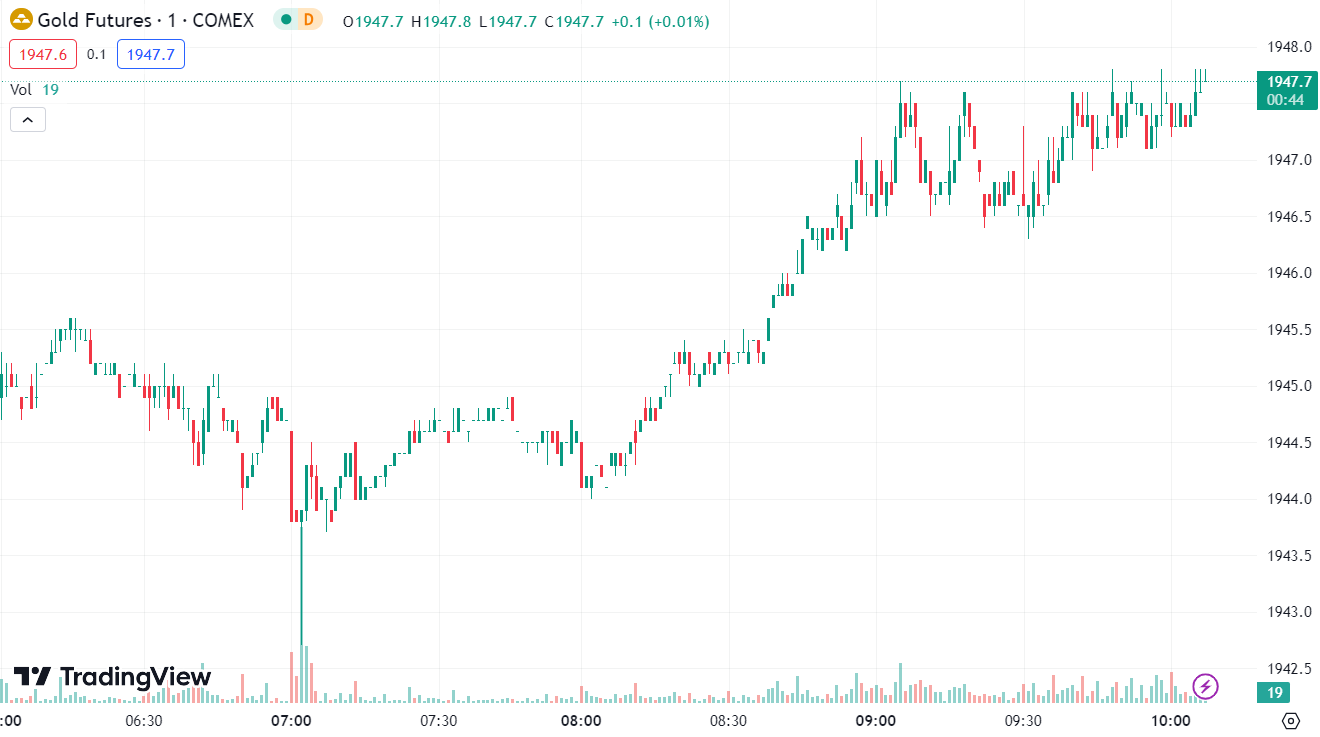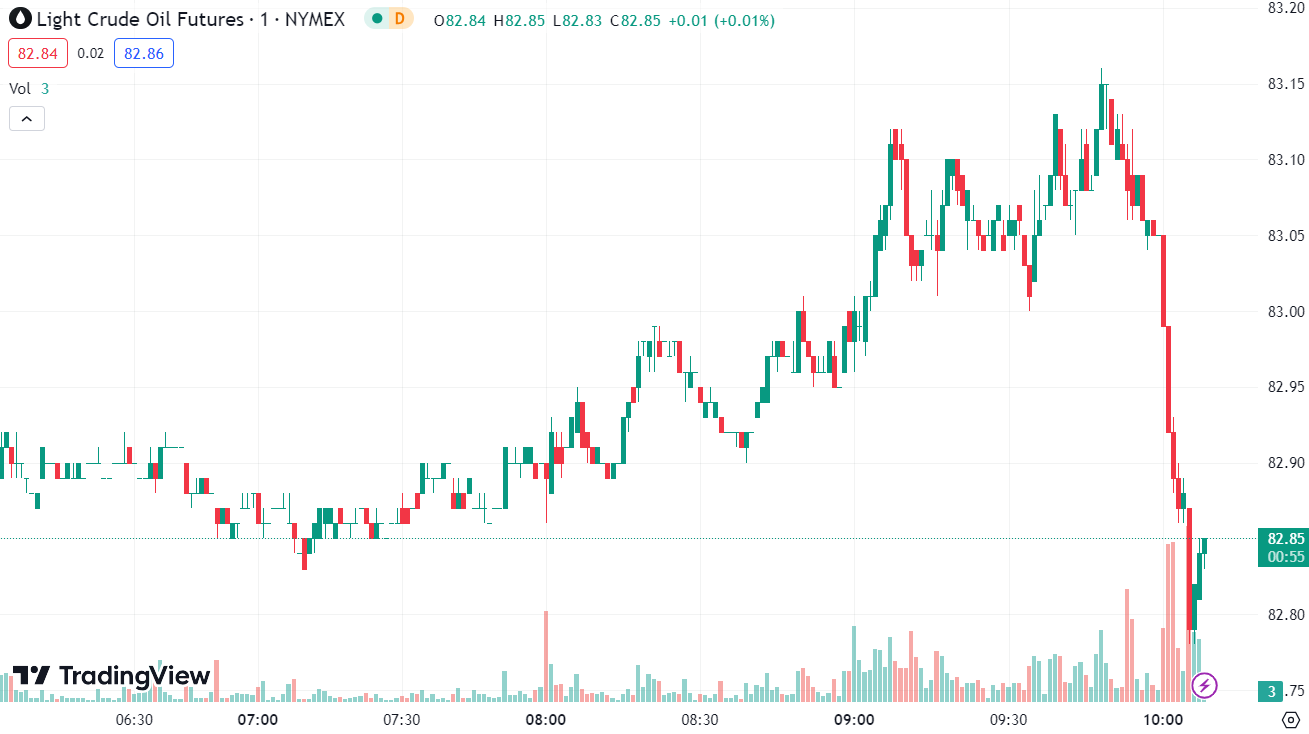
U.S. data revealed a slight uptick in the Consumer Price Index for July, but inflation still remains well above the Federal Reserve’s target of 2%.
This caused gold prices to initially rise but then retreat. Saudi Arabia and Russia extended their production cuts, while tensions in the Black Sea region raised concerns about oil transportation, leading to a surge in U.S. crude oil prices, briefly hitting their highest level this year.
Gold >>
On Thursday, the U.S. Department of Labor released the Consumer Price Index (CPI) data, revealing a 3.2% year-on-year increase in July, ending a 12-month streak of decline.
The index also rose 0.2% month-on-month, maintaining the same pace as the previous two months, marking the smallest year-on-year increase since March 2021.
This data solidified expectations of an approaching end to the Federal Reserve’s rate hike cycle, causing the U.S. dollar to retreat. Amidst fluctuating trade, the benchmark 10-year U.S. Treasury yield climbed, curbing the upward momentum of gold.
Following the data release, spot gold briefly surged by $8 to $1930.19 per ounce, only to retreat below $1920 per ounce. Gold prices experienced a rapid rise and fall.
Elevated interest rates have increased the opportunity cost of holding non-yielding gold, leading to a more than 7% decline in the opportunity cost of holding gold since reaching near historical highs in May.
Gold once again surged and retreated on Thursday, prompted by stimulus from the news cycle during the US session.
After a rapid surge above $1930, prices started to retreat, with the pressure from the daily moving average system and the formation of a long upper shadow in the surge-and-retreat pattern potentially facilitating bearish movement in the future. The support for gold remains around the $1905 mark.
Technical Analysis:

For today’s short-term gold trading strategy, it’s recommended to focus on selling during rebounds, with buying during pullbacks considered as secondary.
- Key resistance levels in the short term are observed around 1930-1936.
- Key support levels in the short term are monitored at 1900-1904.
WTI Crude Oil >>
On Thursday, US crude oil briefly reached its highest price of the year, while Brent crude remained close to its January peak.
The release of US inflation data led to reduced speculation about further rate hikes in the US, while the Organization of the Petroleum Exporting Countries (OPEC) maintained an optimistic outlook on oil demand.
In recent days, the extension of production cuts by Saudi Arabia and Russia, along with the conflict between Russia and Ukraine in the Black Sea region potentially affecting Russian oil transportation, has sparked supply concerns, thereby boosting oil prices.
A significant reduction in US gasoline inventories has further supported bullish sentiment for crude oil, driving prices close to the $85 per barrel mark.
The day’s agenda includes the release of US CPI data and the OPEC monthly report. If the OPEC report indicates decreased output from Saudi Arabia and Russia, oil prices could aim for the short-term target of $90 per barrel. However, attention must be given to remarks from US Federal Reserve officials scheduled for Friday morning.
Crude oil experienced a high and then a subsequent retracement on the previous day, initially surging around the $84.90 level before encountering resistance. During the European and American trading sessions, there was a corrective pullback, resulting in a small bearish candlestick on the daily chart.
Technical Analysis:

Today’s short-term trading strategy suggests focusing primarily on buying at low points during pullbacks, with selling on high rebounds as a secondary approach.
- Key resistance levels to monitor in the short term are between 84.4 and 85.0.
- Key support levels to monitor in the short term are between 81.0 to 81.6.
Forward-looking Statements
This article contains “forward-looking statements” and may be identified by the use of forward-looking terminology such as “anticipate”, “believe”, “continue”, “could”, “estimate”, “expect”, “hope”, “intend”, “may”, “might”, “plan”, “potential”, “predict”, “should”, or “will”, or other variations thereon or comparable terminology. However, the absence of such terminology does not mean that a statement is not forward-looking. In particular, statements about the expectations, beliefs, plans, objectives, assumptions, future events, or future performance of Doo Prime will be generally assumed as forward-looking statements.
Doo Prime has provided these forward-looking statements based on all current information available to Doo Prime and Doo Prime’s current expectations, assumptions, estimates, and projections. While Doo Prime believes these expectations, assumptions, estimations, and projections are reasonable, these forward-looking statements are only predictions and involve known and unknown risks and uncertainties, many of which are beyond Doo Prime’s control. Such risks and uncertainties may cause results, performance, or achievements materially different from those expressed or implied by the forward-looking statements.
Doo Prime does not provide any representation or warranty on the reliability, accuracy, or completeness of such statements. Doo Prime is not obliged to provide or release any updates or revisions to any forward-looking statements.
Disclaimer
While every effort has been made to ensure the accuracy of the information in this document, DOO Prime does not warrant or guarantee the accuracy, completeness or reliability of this information. DOO Prime does not accept responsibility for any losses or damages arising directly or indirectly, from the use of this document. The material contained in this document is provided solely for general information and educational purposes and is not and should not be construed as, an offer to buy or sell, or as a solicitation of an offer to buy or sell, securities, futures, options, bonds or any other relevant financial instruments or investments. Nothing in this document should be taken as making any recommendations or providing any investment or other advice with respect to the purchase, sale or other disposition of financial instruments, any related products or any other products, securities or investments. Trading involves risk and you are advised to exercise caution in relation to the report. Before making any investment decision, prospective investors should seek advice from their own financial advisers, take into account their individual financial needs and circumstances and carefully consider the risks associated with such investment decision.


